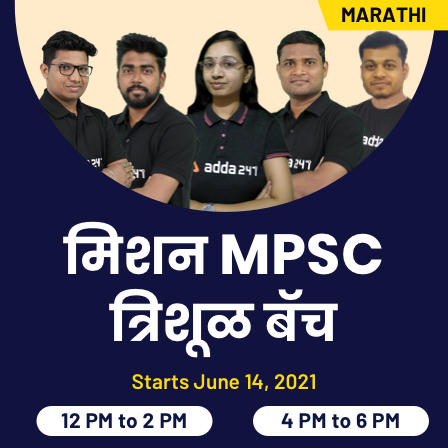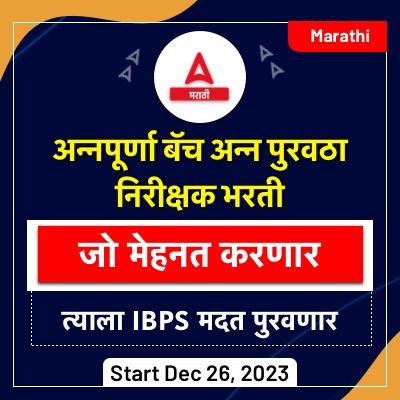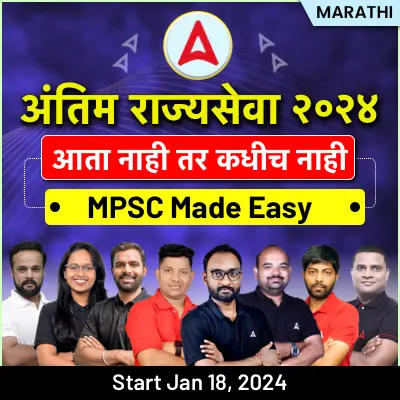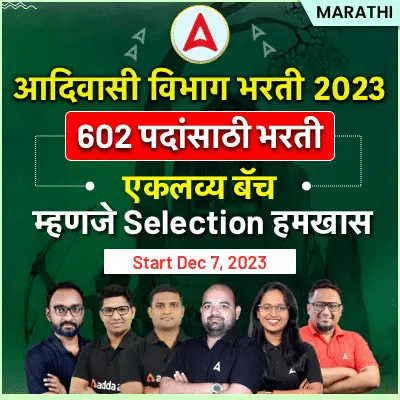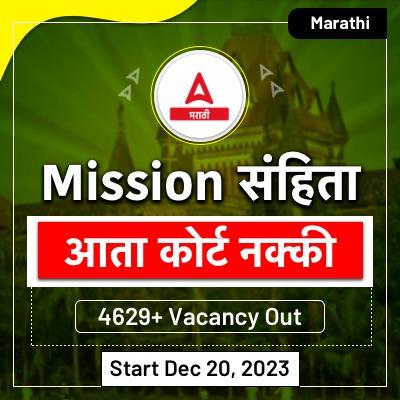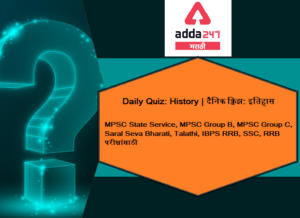
इतिहास दैनिक क्विझ मराठीमध्ये: 29 मे 2021
महाराष्ट्र राज्य लोकसेवा आयोग दरवर्षी वेगवेगळ्या परीक्षे मार्फत हजारो विद्यार्थ्यांची भरती करून घेते MPSC State Service, MPSC Group B, MPSC Group C, Saral Seva Bharati, Talathi, UPSC, SSC, RRB अशा अनेक परीक्षांमार्फत हजारो जागांची भरती दरवर्षी निघते ज्यात लाखो इच्छुक हजार किंवा त्याहूनही कमी जागांसाठी अर्ज करतात. आपण एमपीएससी आणि इतर परीक्षाची तयारी करत असाल तर आपल्याला क्विझ देण्याचे महत्त्व माहित असलेच पाहिजे. बर्याच विद्यार्थ्यांना अभ्यासाचे पुरेसे तास दिले जात असतानाही त्यांना या परीक्षांची पूर्तताही करता आली नाही कारण ते त्यांचे परीक्षण वेळेवर पूर्ण करू शकत नाहीत आणि संशोधन करण्याचा उत्तम मार्ग म्हणजे त्या संबंधित विषयाची किंवा विषयाची क्विझ देणे कारण आपण या मार्गाने कव्हर करू शकता कमी वेळात जास्तीत जास्त विषय. आम्हाला Add 247 मराठी येथे चांगल्या अभ्यास सामग्रीचे मूल्य समजले आहे आणि म्हणूनच आम्ही सर्व विषयांसाठी आपल्याला क्विझ प्रदान करीत आहोत. दैनिक क्विझ देऊन तुम्ही तुमच्या तयारीची पातळी तपासू शकता.
चालू घडामोडी, भूगोल, अर्थशास्त्र, पर्यावरण, सामान्य विज्ञान, इतिहास, पॉलिटी अशा सर्व स्पर्धात्मक सामान्य अभ्यास विषयांमध्ये इतिहासाचाही महत्वाचा वाटा आहे. तर चला इतिहास बद्दल तुमची तयारी तपासण्यासाठी खालील 29 मे 2021 ची इतिहासाची दैनिक क्विझ पहा.
Q1. सिंधू संस्कृतीसंदर्भात पुढील विधानांचा विचार करा:
1. मोहेंजो-दारो येथील रस्त्यांच्या नाल्यांमध्ये नियमित कालांतराने मॅनहोल होते.
2. सिंधू लोक गायीची सुपीकता देवी म्हणून पूजा करत.
वर दिलेले कोणते विधान/विधाने बरोबर आहे/ आहेत?
(a) फक्त 1
(b) फक्त 2
(c) दोन्ही 1 आणि 2
(d) 1 किंवा 2 देखील नाही
Q2. बौद्ध आणि जैन धर्माच्या सामान्य शिकवणींविषयी खालील विधानांचा विचार करा?
1. दोघांनीही मुक्त मार्गाचा म्हणून मध्यम मार्गाला विरोध केला.
2. दोघांनी कठोर तपस्वीपणा आणि स्वतःच्या पाणउताऱ्याचा पुरस्कार केला.
वर दिलेले कोणते विधान/विधाने बरोबर आहे/ आहेत?
(a) फक्त 1
(b) फक्त 2
(c) दोन्ही 1 आणि 2
(d) 1 किंवा 2 देखील नाही
Q3. महारौली लोहस्तंभ शिलालेख_________च्या विजयांशी संबंधित आहे
(a) अशोक
(b) बिंबिसार
(c) अकबर
(d) चंद्र गुप्ता II.
Q4. जैन धर्माच्या कल्पनांसंदर्भात पुढील विधानांचा विचार करा
1. स्वतःला कर्माच्या चक्रातून मुक्त करण्यासाठी तपस्वी व तपश्चर्ये आवश्यक आहेत.
2. योग्य श्रद्धा, योग्य ज्ञान आणि योग्य एकाग्रता ही जैन धर्माची तीन दागिने आहेत.
वर दिलेले कोणते विधान/विधाने बरोबर आहे/ आहेत?
(a) फक्त 1
(b) फक्त 2
(c) दोन्ही 1 आणि 2
(d) 1 किंवा 2 देखील नाही
Q5. राजा अशोक यांनी तिसरी बौद्ध परिषद कोणाच्या अध्यक्षतेखाली घेतली होती?
(a) अस्वाघोशा
(b) मोगलिपुत्त तिसा
(c) नागसेना
(d) वासू मित्र
Q6. पुढील विधानांचा विचार करा
1. अशोकाच्या धम्मामध्ये एखाद्या देवाची पूजा करणे किंवा यज्ञाचा समावेश नव्हता
2. बौद्ध धर्माची शिकवण पसरवण्यासाठी अजातशत्रुंनी धम्म महात्मा यांची नेमणूक केली होती
वर दिलेले कोणते विधान/विधाने बरोबर आहे/ आहेत?
(a) फक्त 1
(b) फक्त 2
(c) दोन्ही 1 आणि 2
(d) 1 किंवा 2 देखील नाही
Q7. पुढील जोड्यांचा विचार करा
1. तक्षशिला, नालंदा : बंदर शहरे
2. पावर्ण : यज्ञ सोहळा
3. बाराबर लेणी : अजविका संप्रदाय
वरीलपैकी कोणती जोडी /जोड्या बरोबर आहे /आहेत
(a) 1 आणि 2
(b) 2 आणि 3
(c) 1 आणि 3
(d) फक्त 3
Q8. प्रीतिलता वडद्दार यांच्याविषयी खालीलपैकी कोणते बरोबर आहे?
(a) गांधीजींच्या अहिंसेच्या विचारसरणीचे त्यांनी अनुसरण केले.
(b) 1935 च्या कायद्यांतर्गत तिने फेडरल स्ट्रक्चरची मागणी केली.
(c) तिने ब्रिटीशविरूद्ध विरोध करण्यासाठी माध्यम म्हणून पत्रकारितेचा वापर केला.
(d) त्या सूर्य सेनच्या क्रांतिकारक पक्षाची सदस्य होती.
Q9. राणी गायडिनल्यूशी संबंधित होती
(a) भारतीय स्वातंत्र्यलढ्यात नागा संघर्ष विलीन करणे
(b) सत्यशोधक समाजाच्या महिला शाखेचा शुभारंभ
(c) 1857 चा उठाव
(d) बिहारमधील चंपारण सत्याग्रहाचे नेतृत्व केले.
Q10. खालीलपैकी कोणती जोडी/जोड्या योग्य आहे /आहेत ?
(a) अरुणा असफ अली : गृह नियम चळवळ
(b) कल्पना दत्ता : चटगांव आर्मोरी रेड
(c) सुचेता कृपालिनी : अंडर ग्राउंड वॉलंटियर फोर्स
(d) दोन्ही (b) आणि (c)
महाराष्ट्र राज्यातील सर्व स्पर्धा परीक्षांचे मोफत अभ्यास साहित्य
YouTube channel- Adda247 Marathi
App- Adda247 (मराठी भाषा)
Use Coupon code: HAPPY
आणि मिळवा 75% डिस्काउंट
आता तुमच्या घरी लाइव्ह वर्ग मराठीत उपलब्ध आहेत
केवळ सरावच परीक्षेत चांगले गुण मिळण्यास मदत करू शकतो
SBI लिपिक फाउंडेशन बॅच | द्विभाषिक
Solutions
S1.Ans.(a)
Sol.
The Drainage System of the Indus Valley Civilization was far advanced. The street drains had manholes at regular intervals. All soak pits and drains were occasionally cleaned by workmen. The Harrapans looked upon the earth as a fertility goddess and worshipped her. The Indus people were the earliest people to produce cotton. Because cotton was first produced in this area, the Greeks called it Sindon, which is derived from Sindh.
S2.Ans.(d)
Sol.
In respect of their basic philosophical concepts, Buddhism and Jainism were indebted to the Sankhya philosophy. The concept of the Jainas and the Buddhists that the world is misery and that man is subjected to the result of Karma was borrowed from the Upanishads and the Sankhya philosophy. While Buddhism advocated a middle path (following ashtangigamarga) Jainism advocated rigorous asceticism and self-mortification as a way of liberation.
S3.Ans.(d)
Sol.
The “Mahrauli Iron Pillar Inscription” is associated with the conquests of Chandra Gupta II.
S4.Ans.(b)
Sol.
According to Jainism, asceticism and penance are required to free oneself from the cycle of karma. This can be achieved only by renouncing the world; therefore, monastic existence is a necessary condition of salvation. The three jewels in Jainism are Right faith, Right knowledge, and Right action.
S5.Ans.(b)
Sol.
The third Buddhist council was held in 250 BC at Pataliputra under the patronage of King Asoka and under the presidency of Moggaliputta Tissa. The teachings of Buddha which were under two baskets were now classified in 3 baskets as Abhidhamma Pitaka was established in this council, and they were known as “Tripitaka”.
S6.Ans.(a)
Sol.
Ashoka’s dhamma did not involve worship of a god, or performance of a sacrifice. He felt that just as a father tries to teach his children, he had a duty to instruct his subjects. He was also inspired by the teachings of the Buddha
There were a number of problems that troubled him. People in the empire followed different religions, and this sometimes led to conflict. Animals were sacrificed. Slaves and servants were ill-treated. Besides, there were quarrels in families and amongst neighbors. Ashoka felt it was his duty to solve these problems. So, he appointed officials, known as the dhamma mahamatta who went from place to place teaching people about the dhamma
Source: https://ncert.nic.in/ncerts/l/fess108.pdf
S7.Ans.(d)
Sol.
The ancient Buddhist residential places became the centers of learning and Taxila, Nalanda, Vikramshila became centers of Buddhist learning. Pavarna was a ceremony held in ancient Indian Buddhist monasteries. It was the confession by monks of their offenses committed during their stay in the monasteries during the rainy season. Asoka and his grandson Dasaratha got several such cave – dwellings built in the Barabar Hills near Bodh Gaya and donated them to the monks of Buddhism and the Ajivika sect.
S8.Ans.(d)
Sol.
Pritilata Waddedar was a Bengali revolutionary nationalist. After completing her education in Chittagong and Dhaka, she attended Bethune College in Kolkata. Pritilata graduated in philosophy with distinction. After a brief stint as a school teacher, Pritilata joined a revolutionary group headed by Surya Sen. She led a team of fifteen revolutionaries in a 1932 attack on the Pahartali European Club.
S9.Ans.(a)
Sol.
Gaidinliu (1915–1993) was a Naga spiritual and political leader who led a revolt against British rule in India. At the age of 13, she joined the Heraka religious movement of her cousin Haipou Jadonang. The movement later turned into a political movement seeking to drive out the British from Manipur and the surrounding Naga areas.
S10.Ans.(d)
Sol.
Aruna Asaf Ali was associated with Quit India Movement and underground revolutionary activities during the 1942 revolt.
Annie Besant was associated with Home Rule Movement, founded in 1916(it demanded self-rule for India).

